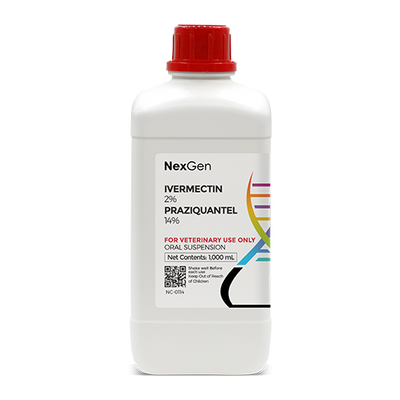
Ivermectin 2 %, Oral Suspension, (500mL)
Login for pricing
- Brand
- Mixlab
- SKU:
- NC-0344
- Product Type:
- Suspension
- Size:
- 500ml
- Administration:
- Oral
Worms are counted among the most common of equine ailments, and all horses are at risk of infestation at any given time. Horses may be affected by numerous different species of worms, and the life cycles and symptoms thereof are varied. Like most parasites, the life cycle of worms includes both eggs and larval stages. The eggs of many worm species which affect horses are ingested from infected pastures and develop inside the horse’s gut or lungs where they have the potential to cause disease. Eggs produced by adult worms are then shed in the horse’s feces, which increases the existing worm burdens on pastures and can then infect other horses.1
Not all worm infections cause clinical signs, so many horses with a low worm burden will not show signs of sickness. However, when present in moderate or larger numbers, worms can severely affect a horse’s health and can result in poor thrift, colic and general ill health. In severe cases, they can damage a horse’s intestines and other internal organs, sometimes causing irreversible harm with potentially fatal consequences. Symptoms typically range from mild (weight loss, mild to intermittent colic) to extremely severe (surgical colic, death).
Species of worms that affect horses include:
Small Redworms (Cyathostomes)
Small redworms are the most common internal parasite of horses. These worms produce larvae that hibernate in the gut wall during the winter and emerge in large numbers as adults in the spring, causing severe damage to the intestines.1There are approximately 50 different species of small redworms, with a worldwide distribution. Most horses will become infected or have been infected with these worms at some point in their lives. Cyathostomes can cause weight loss, diarrhea and colic with potentially fatal consequences, particularly at the time of emergence.1
Large Redworms (Strongyles)
Large redworms (e.g., Strongylus vulgaris, S. edentatus and S. equinus) are among the most dangerous internal parasites of horses.1 They can cause serious symptoms, with severe infection being life-threatening. The life cycle of strongyles includes a larval stage during which larva migrate in the blood vessels, causing anemia and blood clots. These worms can eat through the lining of the gut wall and travel through the blood vessels of the gut, causing significant bleeding. This may result in rapid weight loss, diarrhea and surgical colic, with severe cases leading to death.
Roundworms (Ascarids)
Parascaris equorum is the roundworm most commonly affecting horses.1 The adult worms are large, measuring up to 50 cm in length and 6 mm wide. These worms are particularly serious in young foals, as they can cause impactions (blockages of the intestine) that may require surgery. Roundworm larvae can migrate through the gut wall, to the liver and then the lungs. The larvae are coughed up and swallowed where they mature to egg-laying adults within the gut. Roundworms can cause respiratory signs (cough and/or nasal discharge) as the larvae journey through the lungs, or they can cause gastrointestinal symptoms such as weight loss, diarrhea or a pot-bellied appearance.1
Threadworms
Threadworms remain dormant in adult horses, but can transfer to newborn foals through the mare’s milk.1 With an underdeveloped immune response, this leaves the foal susceptible to diarrhea and anemia, and its growth may also be affected. It is common practice to worm foals against threadworms as early as 4 weeks old; worming the mare during pregnancy can aid in reducing the number of worms transferring to the foal. Natural immunity to threadworms usually develops by 6 months of age.1
Tapeworms (Cestodes)
The equine tapeworm (Anoplocephala perfoliata) is present in most places where horses have pasture access.2 Thus, the majority of horses harboring tapeworms tolerate them without any clinical signs. The presence of tapeworms depends on climatic conditions favoring the orbibatid mite, an intermediate host.1,2 In the horse, tapeworms typically grow to approximately 8cm and form into clusters at the junction between the small and large intestines. Here, they can cause digestive disturbances, loss of condition, colic and fatal blockages.
Pinworms
Pinworms (Oxyuris equi) have the potential to damage a horse’s bowel prior to laying eggs around the outside of the anus, which causes intense itching and irritation.1 Unlike many of the worms that affect horses, pinworms do not migrate through organ tissue. Female pinworms crawl out of the horse's rectum, deposit eggs in the perianal region, then crawl back into the rectum. The infective pinworm eggs are ingested orally; once in the colon, the larvae develop through various stages before becoming sexually mature. Irritation can lead to persistent scratching which results in hair loss and sores around the tail head; this is often one of the most prominent signs of infestation.
Where to buy Ivermectin
Ivermectin is available in the U.S. through pharmaceutical manufacturers and through veterinary custom compounding companies.
Ivermectin carries several potential drug interactions. Please consult your veterinarian prior to beginning any treatment regimen.
FOR RX ONLY: A valid prescription from a licensed veterinarian is required for dispensing this medication.
2aaep.org.
3Merck Veterinary Manual.




















